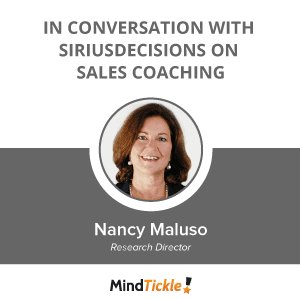 This post is based on a webinar with Nancy Maluso, Research Director for SiriusDecisions. You can listen to the entire webinar here.
This post is based on a webinar with Nancy Maluso, Research Director for SiriusDecisions. You can listen to the entire webinar here.
SiriusDecisions empowers marketing, sales, and product professionals to make better decisions, execute with precision and accelerate growth. Nancy Maluso has built and managed successful teams in the technology industry and now brings her passion for improving sales productivity to her research at SiriusDecision.
“Coaching is something that I love. It’s something that actually moves the needle and helps people perform better,” exclaims Maluso. “According to Wikipedia, the know it all of all things Internet, coaching is a form of development in which a person called the coach supports a learner or client in achieving a specific personal or professional goal by providing training, advice, and guidance.”
Coaching has been proven to work and sales reps find it valuable. “When we asked high performers where they see value in coaching they said, for example, that on deal collaboration and navigating internal resources coaching was extremely important to their job performance,” says Maluso. “Yet, overall, 22% of reps don’t receive any coaching and only 36% of sales reps actually made quota. The average turnover of B2B sales professionals is about 32% annually, meaning 3 out of 10 territories are left uncovered. And when we surveyed top sales leaders we found that 7 out of the 10 inhibitors to growth have to do with sales skills.”
There is clearly a disconnect. If sales coaching is so valuable to reps’ performance, why aren’t more reps being coached? According to Maluso, for a coaching program to be successful, it must include four critical factors. “First, coaching is an individual game. It’s based on the needs of the individual. We have to have some way of knowing what someone needs in terms of coaching.
The second is a competency map. What skills, knowledge, process, expertise, and tools does an individual sales rep have to have to be good at their job? Thirdly, we need insight, both data, and observations, that allow us to know what the individual needs to be coached on. Effective coaching programs are prescriptive, proactive and persistent. We found that if we don’t provide sales managers and sales leaders with a process and a program combined with some tools to help augment the coaching effort, it typically doesn’t happen.
Finally, there need to be actions that the individual is going to take to make a difference.” When all of these factors are in place sales coaching will be most effective. But successful coaching requires more than just a process.
“From a cultural perspective, we want the program to be constructive, not punitive. Part of that is asking reps to identify and self-correct wherever possible. To have the coach support their sales effort persistently through every stage. It’s not just at the end of a win/loss review for example. It’s before they go to have a conversation with the client; it’s not punitive, it’s supportive,” explains Maluso.
Coaching is also a continuous process, it has no defined endpoint. “If a rep has mastered what they need to do with their job, coaching should continue to help develop them for the thing they want to achieve next. Whether it’s leadership roles or specialization, coaching should continue to support that rep,” suggests Maluso.
Persistence is another important quality in an effective sales coaching program according to Maluso.
“We’ve had clients say to us, “Well I do coaching every quarter. I do it at the quarterly business review.” That’s not coaching. it’s persistent and it’s proactive, and it’s always on,” she explains. To create a program that is persistent and proactive you have to have insights. That’s where the competency map comes in.
“It defines what reps need to be able to do. Then it’s looking at metrics that say, “Are they doing that?” Hopefully, your tools track activities that reps undertake so you can see if they are they making the right number of calls. Are they having the right number of customer engagements? Doing the right number of demos?” she suggests.
Useful information can be gleaned from lagging indicators like your sales funnel or win/loss ratios.
“For example, if the funnel is fat in the middle, but narrow at the top and narrow at the bottom, it might indicate a few things,” she says. “Metrics don’t tell you precisely what’s wrong, they give you indicators. Just like if you hit a golf shot and it goes to the right, a good golf coach will have a sense of why that might be. But until they inspect your actual swing, they’re not going to know specifically what’s wrong with your particular mechanics. The same is true with the sales rep. The dashboard gives indicators, things to probe on. If the funnel’s fat, we might look at, well, are they having trouble with solution design? Maybe they’re not engaging their sales engineer properly. Perhaps they don’t know how to use the CPQ tool. Only by observing them in their work will you know or sure.”
To really understand what’s going on insights have to meet with reality. Data provides one view, but it’s not until you observe what a rep is doing on a regular basis that you can identify how to effectively make a difference. “Managers aren’t observing reps to be Big Brother. It’s about understanding what the rep needs,” she explains.
Observing reps so that you can coach them and make a real difference to their performance requires cadence. That’s where the right tools are so crucial. “Processes and tools can help us make coaching a regular part of weekly one-on-one calls, a regular part of prep before customer calls. Coaching can also be done in groups, talking about individual needs so others can learn. It can be done in a lot of different ways, and processes and tools help us automate some of that process. Bring forward the insights and link them to potential tools that can help us support the rep,” suggests Maluso.
“In my example of the fat funnel, let’s say on observation the manager realizes that they don’t really do enough qualifying questions up front so they’re not able to design a solution effectively, and so things get stuck in the middle. Well by observing that the coaching tool can provide a discovery list of questions that can help in solution design, or a video of a rep who’s showing and demonstrating how to do this well or a role play that they can practice to help them get better. Those are the kinds of tools you can provide to managers so that they can coach more effectively,” she continues.
Good coaching programs are also prescriptive and link actions to outcomes.“They are very specific about what needs to be done. What the rep needs to do is understand what actions they need to take that are different. They need to practice those actions and establish a pattern where the action results in impact. Linking what they’re doing or practicing with the outcome you’re looking for is absolutely critical. You want to record in your tool or within your process exactly what coaching is going on and what we’ve asked of the reps or we’ve asked of ourselves as coaches to help them,” she explains.
One final tip from Maluso is to look at data holistically.“Look for patterns. We might see that all reps are having trouble with discovery; not just yours. We can then go back to product marketing and work with them to develop the right tools and maybe a training webinar on how to do effective discovery,” she suggests. By creating a coaching program that is prescriptive, proactive and persistent you can create a culture of support. This puts the development of your reps front and center, where it should be.
- Revenue Productivity Platform
Revenue Productivity Platform
One platform to enable customer-facing teams and execute on open deals.
Meet Copilot
Your generative AI productivity assistant
For Revenue Enablement
Sales Enablement & Training
Build rep knowledge and skills with practice and AI-assisted reinforcement.
Sales Content Management
Align content to skills, sales processes, and customer needs
Sales Coaching
Optimize performance and skill gaps with personalized coaching
Readiness Index™
Identify your Ideal Rep Profile™ and tie skills to sales success
Browse by Module
For Revenue Operations
Conversation Intelligence
Understand field performance during customer interactions
Sales Forecasting (RO&I)
Get complete visibility into your pipeline health and take actions that boost revenue.
Digital Sales Rooms
Collaborate with your buying teams on content and mutual action plans.
Analytics & Dashboards
Measure the progress of your team on knowledge, skills, and deal behaviors
Integrations
Learn how Mindtickle works seamlessly with your stack
Services
Mindtickle’s advisory, professional, and content services that ensure your programs succeed
Pre-Built Training
Launch enablement quickly with templates and ready-to-deploy programs
Content as a Service
Work with our in-house team of content experts to convert your content into engaging digital experiences
Explore Options
- Solutions
Sales Readiness Solutions
Focus on your team's sales training and coaching needs with comprehensive readiness solutions.
Sales Onboarding
Ramp new sales team members quickly with learning that sticks
Sales Training
Build knowledge with ongoing programs, missions and content
Manager-Led Coaching
Create a coaching culture with personalized tools
Account Strategy & Review
Leverage field evidence to inform your growth plans
By Use Case
Sales Kickoffs
Use kickoffs and live instructor-led sessions to drive skill development
Partner Enablement
Get your partners scaled quickly and keep them updated
Sales Certification
Ensure reps are ready to implement skills in the field
Voice of the Customer
Gain complete insight into customer expectations
Sales Enablement
Teach your teams, track and address skill gaps systematically
Sales Leadership
Set the true north for sales excellence
Frontline Managers
Know where your reps need skill development and coach them
Sales Ops
Report on data from enablement, content, and sales
By Role
- Customers
Our Customers
Explore how customers use Mindtickle to build best-in-class sales enablement programs.
Customer Stories
Read how other customers use Mindtickle to impact sales performance and productivity
Customer Video Testimonials
Hear firsthand from our customers
- Resources
Sales Readiness Resources
We're dedicated to sharing everything we've learned. Browse the best from the sales readiness experts at Mindtickle.
Resources Hub
Insights, guides reports, checklists, videos and more. Filter and browse our full arsenal of helpful resources
Blog
Expert sales content for today’s revenue organization
On-demand Webinars
Live and On-demand events you won’t want to miss
Events
Sales events you won’t want to miss
Product Tours
Take a self-guided tour of Mindtickle.
Revenue Hub
Virtual library for everything you need to lead a sales enablement strategy that ensures sellers meet and beat quota every quarter.
Ready or Not? Video Series
Bite-sized tip videos to get your team sales-ready.
Ready, Set, Sell: A Mindtickle Podcast
Ready, Set, Sell focuses on sales performance, productivity, and continuous training to create entire teams of high performers.
What is Revenue Productivity?
How it enhances sales performance by utilizing seller data, revenue analytics, sales enablement, and front-line sales coaching.
State of Sales Productivity Report
Learn how winning sales orgs run their teams.
Featured Resource
What’s your Revenue Enablement IQ?
Discover your revenue enablement IQ.
- Company
About Mindtickle
Meet Mindtickle. We’re a leading sales enablement company that thrives on creating impact for our customers.
Contact Us
Have a question? Connect with our team and get answers.
- Request A Demo








